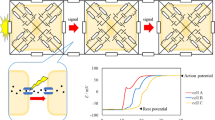Abstract
Under voltage clamp conditions, using the double mannitol gap technique, ionic currents developed by fast (e.d.l.) and slow (soleus) twitch muscle fibers of the rat were analysed at different times following denervation and the results compared with those obtained in normal cells. In slow fibers, denervation, caused the appearance of a new population of TTX-resistant Na+ channels (dissociation constantK 2=2,800 nM) compared with the normal TTX-sensitive Na+ channels (K 1=9 nM). This new population of Na channels appeared in 5 days and contributed about 32% of the total Na conductance. Denervated fast fibres developed a slow component in the delayed outward current which was found to be, typical of slow innervated muscles. This component appeared 5 to 20 days after nerve section. These changes are associated with modifications of potassium channels' sensitivity for specific inhibitors (TEA and 4-AP). After denervation, the delayed outward current in the two types of muscles becomes resistant to 4-AP whereas TEA, which blocks the total delayed outward current in innervated fibers (dissociation constant of 21.4 mM) becomes more effective in blocking the fast component (dissociation constant of 0.61 mM) and less effective in blocking the slow component in denervated cells. The analysis of the characteristics of the TEA sensitive and TEA insensitive components of the outward current leads to the proposal that these components were related to the fast and to the slow components previously described in fast and slow twitch mammalian skeletal muscles.
Similar content being viewed by others
References
Albuquerque EX, McIsaac RJ (1970) Fast and slow mammalian muscles after denervation. Exp Neurol 26:183–202
Albuquerque EX, Schuh FY, Kauffman FC (1971) Early membrane depolarization of the fast mammalian after denervation. Pflügers Arch 328:36–50
Albuquerque EX, Thesleff S (1968) A comparative study of membrane properties of innervated and chronically denervated fast and slow skeletal muscles of the rat. Acta Physiol Scand 73:471–480
Bray JJ, Hawken MJ, Hubbard JI, Pockett S, Wilson L (1976)_The membrane potential of rat diaphragm muscle fibres and the effect of denervation. J Physiol 255:651–667
Colquhoun D, Rang HP, Ritchie JM (1974) The binding of tetrodotoxin and alpha-bungarotoxin to normal and denervated mammalian muscle. J Physiol 240:199–226
Duval A, Léoty C (1978) Ionic currents in mammalian fast skeletal muscle. J Physiol 278:403–423
Duval A, Léoty C (1980a) Ionic currents in slow twitch skeletal muscle in the rat. J Physiol 307:23–41
Duval A, Léoty C (1980b) Comparison between the delayed outward current in slow and fast twitch skeletal muscle in the rat. J Physiol 307:43–57
Duval A, Léoty C (1984) Effects of denervation on ionic currents in rat fast and slow twitch skeletal muscles. J Physiol 350:50P
Gillespie JI, Hutter OF (1975) The actions of 4-aminopyridine on the delayed potassium current in skeletal muscle fibres. J Physiol 252:70P
Grampp W, Harris JB, Thesleff S (1972) Inhibition of denervation changes in skeletal muscle by blockers of protein synthesis. J Physiol 221:743–754
Guth L (1968) “Trophic” influences of nerve on muscle. Physiol Rev 48:645–687
Gutmann E (1976) Neurotrophic relation. Annu Rev Phyisol 38:177–216
Hansen Bay C, Strichartz GR (1980) Saxitoxin binding to sodium channels of rat skeletal muscles. J Physiol 300:89–103
Hille B, Campbell DT (1976) An improved vaseline gap voltage clamp for skeletal muscle fibres. J Gen Physiol 67:265–293
Léoty C, Alix J (1976) Some technical improvements for the voltage clamp with the double sucrose gap. Pflügers Arch 365:95–97
Léoty C, Léauté M (1982) Membrane potential and contractures in segments cut from rat fast and slow twitch muscles. Pflügers Arch 395:42–48
Lewis DM (1972) The effect of denervation on the mechanical and electrical responses of fast and slow mammalian twitch muscle. J Physiol 222:51–75
Lorkovic H, Tomanek RJ (1977) Potassium and chloride conductances in normal and denervated rat muscles. Amer J Physiol 232:C109-C114
McArdle JJ (1983) Molecular aspects of the trophic influence of nerve on muscle. Prog Neurobiol 21:135–198
McArdle JJ, Michelson L, d'Alonzo AJ (1980) Action potentials in fast- and slow-twitch mammalian muscles during re-innervation and development. J Gen Physiol 75:655–672
Pappone PA (1980) Voltage-clamp experiments in normal and denervated mammalian skeletal muscle fibres. J Physiol 306:377–410
Ranatunga KW (1977) Changes produced by chronic denervation in the temperature-dependent isometric contractile characteristics of rat fast and slow twitch skeletal muscles. J Physiol 273:255–262
Redfern P, Thesleff S (1971a) Action potential generation in denervated rat skeletal muscle. Part I. Quantitative aspects. Acta Physiol Scand 81:557–564
Redfern P, Thesleff S (1971b) Action potential generation in denervated rat skeletal muscle. Part II. The action of tetrodotoxin. Acta Physiol Scand 82:70–78
Shabunova J, Vyskocil F (1982) Postdenervation changes of intracellular potassium and sodium measured by ion selective microelectrodes in rat soleus and extensor digitorum longus muscle fibres. Pflügers Arch 394:161–164
Stanfield PR (1970) The effect of the tetraethylammonim ion on the delayed currents of frog skeletal muscle. J Physiol 209:209–229
Ware R, Bennett AL, McIntyre AR (1954) Membrane resting potential of denervated mammalian skeletal muscle measured in vivo. Amer J Physiol 177:115–118
Wareham AC (1978) Effect of denervation and ouabain on the response of the resting membrane potential of rat skeletal muscle to potassium. Pflügers Arch 373:225–228
Author information
Authors and Affiliations
Rights and permissions
About this article
Cite this article
Duval, A., Léoty, C. Changes in the ionic currents sensitivity to inhibitors in twitch rat skeletal muscles following denervation. Pflugers Arch. 403, 407–414 (1985). https://doi.org/10.1007/BF00589254
Received:
Accepted:
Issue Date:
DOI: https://doi.org/10.1007/BF00589254




